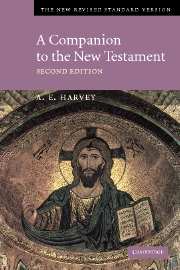Book contents
- Frontmatter
- Contents
- Preface
- Preface to the First Edition (1970)
- THE NEW TESTAMENT
- THE GOSPELS
- THE ACTS OF THE APOSTLES
- LETTERS
- Romans
- 1 Corinthians
- 2 Corinthians
- Galatians
- Ephesians
- Philippians
- Colossians
- 1 Thessalonians
- 2 Thessalonians
- 1 Timothy
- 2 Timothy
- Titus
- Philemon
- Hebrews
- James
- 1 Peter
- 2 Peter
- 1 John
- 2 John
- 3 John
- Jude
- THE REVELATION
- Old Testament References
- Index
- Frontmatter
- Contents
- Preface
- Preface to the First Edition (1970)
- THE NEW TESTAMENT
- THE GOSPELS
- THE ACTS OF THE APOSTLES
- LETTERS
- Romans
- 1 Corinthians
- 2 Corinthians
- Galatians
- Ephesians
- Philippians
- Colossians
- 1 Thessalonians
- 2 Thessalonians
- 1 Timothy
- 2 Timothy
- Titus
- Philemon
- Hebrews
- James
- 1 Peter
- 2 Peter
- 1 John
- 2 John
- 3 John
- Jude
- THE REVELATION
- Old Testament References
- Index
Summary
As early as the second century ce this writing was referred to by ancient authors under the title ‘To Hebrews’. If, at that date, they knew any more about it – who was the author, why it was written – they have not told us. Indeed, even this title tells us nothing we could not have inferred for ourselves. Whoever was originally intended to read the letter must have been familiar not only with the Jewish scriptures and institutions but also with current Jewish methods of interpretation: without a ‘Hebrew’ background it would have been difficult to follow the argument. It would seem to follow that the first readers were Jewish Christians – either Jews or proselytes. But even this conclusion is not certain. They could conceivably have been Gentiles who had spent many years attending a Jewish synagogue without actually converting to Judaism (like the probable recipients of Paul's letter to the Galatians: see above, pp.). The traditional title, to the hebrews, is therefore not certainly correct. But so far as it goes it is a reasonable guess.
It is less obviously appropriate to call the work a letter. It is true that it ends, as letters should, with some personal greetings; but at the beginning, where one normally looks for some indication of who is writing and to whom, there is nothing of the kind.
- Type
- Chapter
- Information
- A Companion to the New Testament , pp. 685 - 719Publisher: Cambridge University PressPrint publication year: 2004



